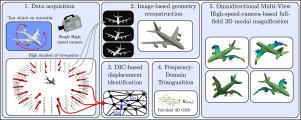Omnidirectional multi-view high-speed-camera-based full-field 3D modal identification
IF 8.9
1区 工程技术
Q1 ENGINEERING, MECHANICAL
引用次数: 0
Abstract
Structures with complex geometries often exhibit elaborate spatial responses to a dynamic excitation. Traditional point-wise vibration measurement techniques, such as accelerometer measurements, provide reliable results usually lacking spatial resolution. In contrast, image-based displacement identification methods provide full-field non-contact measurement capabilities at the cost of a lower dynamic range. Furthermore, 3D digital image correlation is able to reconstruct the geometry and spatial displacements of structures, but require multi-camera setups to work. In the case of omnidirectional experimental modal analysis, frequency-domain stitching is required. This research builds on the recently introduced, multi-view, frequency-domain-triangulation method, that provides a framework for the extraction of full-field 3D operating deflection shapes with a high dynamic range. The existing method is based on sequential high-speed recordings of the vibrating structure made from different views; however, to work it requires prior knowledge of the structure’s geometry. In this research, following an initial camera calibration, a 3D surface mesh is extracted using a photogrammetric geometry reconstruction approach. Displacements of the vibrating object are then recorded and extracted from a large number of views and full-field 3D operating deflection shapes are extracted using frequency-domain triangulation. In the final step, the deflection shapes are magnified and mapped to the reconstructed 3D surface mesh to visualize the vibrational behavior of the test subject. The results of the introduced method for the extraction and visualization of full-field 3D deflection shapes do not require any prior knowledge regarding the geometric or dynamic properties of the studied object. The considerable over-determination in the frequency domain of measurement data obtained from the large number of viewpoints leads to a larger dynamic range and a better reconstruction.

基于全向多视角高速摄像机的全视野三维模态识别
具有复杂几何形状的结构往往对动态激励表现出复杂的空间响应。传统的点向振动测量技术,如加速度计测量,提供可靠的结果,但通常缺乏空间分辨率。相比之下,基于图像的位移识别方法以较低的动态范围为代价提供了全场非接触式测量能力。此外,3D数字图像相关能够重建结构的几何和空间位移,但需要多相机设置才能工作。在全向试验模态分析中,需要进行频域拼接。本研究建立在最近推出的多视图频域三角测量方法的基础上,该方法为提取高动态范围的全场三维操作偏转形状提供了框架。现有的方法是基于从不同角度对振动结构进行连续高速记录;然而,要使用它,需要事先了解结构的几何形状。在本研究中,在初始相机校准之后,使用摄影测量几何重建方法提取3D表面网格。然后从大量视图中记录和提取振动物体的位移,并使用频域三角测量提取全场3D操作挠度形状。在最后一步中,将变形形状放大并映射到重建的三维表面网格中,以可视化测试对象的振动行为。所介绍的方法的结果用于提取和可视化的全场三维偏转形状不需要任何先验知识,关于研究对象的几何或动态特性。由于从大量视点获得的测量数据在频域有相当大的过定,使得动态范围更大,重建效果更好。
本文章由计算机程序翻译,如有差异,请以英文原文为准。
求助全文
约1分钟内获得全文
求助全文
来源期刊

Mechanical Systems and Signal Processing
工程技术-工程:机械
CiteScore
14.80
自引率
13.10%
发文量
1183
审稿时长
5.4 months
期刊介绍:
Journal Name: Mechanical Systems and Signal Processing (MSSP)
Interdisciplinary Focus:
Mechanical, Aerospace, and Civil Engineering
Purpose:Reporting scientific advancements of the highest quality
Arising from new techniques in sensing, instrumentation, signal processing, modelling, and control of dynamic systems
 求助内容:
求助内容: 应助结果提醒方式:
应助结果提醒方式:


